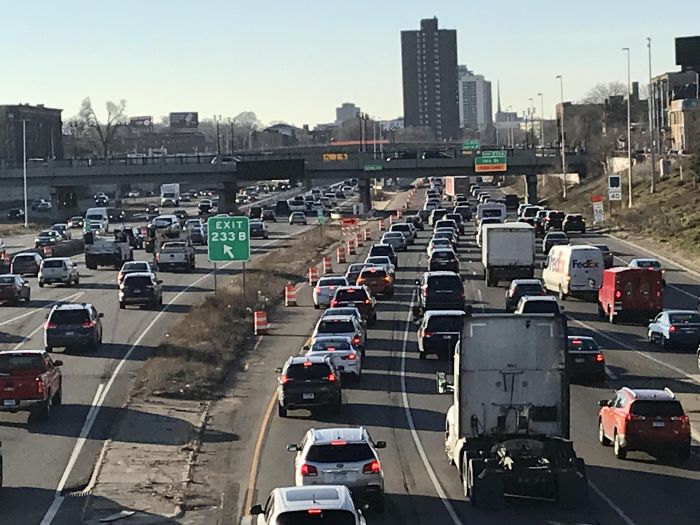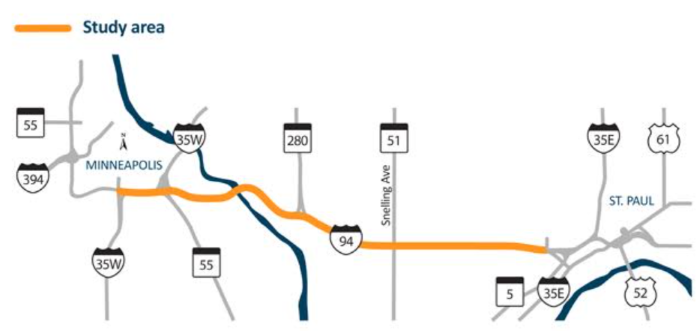
Traffic and pollution on I-94 in Minneapolis
By Emilie Wille
Saint Paul’s historic Rondo neighborhood is a thriving, diverse community and home to many immigrant families and Black owned businesses. It’s situated between University Avenue and the METRO Green Line to the north, and Selby Avenue to the south. Black churches, businesses, and schools set down roots in the area in the late nineteenth and early twentieth centuries, creating a strong community. Today, the area remains a diverse cultural center with the annual Rondo Days Celebration, Rondo Commemorative Plaza, and Community Outreach Library.
But Rondo also has a history shaped by racist highway construction, and right now we have a chance to right this past wrong. The neighborhood suffered tremendously as its heart was demolished to make way for the I-94 highway. In 1956, when ground was broken for the highway, Rondo was literally torn apart. Over 600 homes and 300 businesses were destroyed, displacing one in eight Black residents of St. Paul.
Rondo’s story is not unique. Hundreds of neighborhoods across the country, disproportionately home to communities of color, have been damaged by the interstate highway system. This widespread harm makes highway construction one of the largest perpetrators of environmental racism in the United States.
Now, the Minnesota Department of Transportation (MnDOT) reports that over 150,000 vehicles speed along I-94 every day, carrying Minnesotans to their destinations while also spewing toxic emissions, contributing to climate change, and creating noise from tailpipes, wheels, and truck brakes.

MnDOT is planning for the full reconstruction of I-94, between downtown Minneapolis and downtown Saint Paul. This provides an opportunity to repair some of the harm for Rondo and for all the Twin Cities neighborhoods affected by the interstate highway. The "Rethinking I-94” Project aims to correct past injustices, “reconnect neighborhoods, revitalize communities and ensure residents have a meaningful voice in transportation decisions that affect their lives.”
Sierra Club, neighborhoods, and local community organizations are heavily involved to ensure the project benefits people — and doesn't just lead to more traffic and pollution. On December 4, 2020 twenty-five organizations wrote MnDOT Commissioner Margaret Anderson Kelliher and FHWA Administrator Wendell Meyer with the peoples’ priorities.
One organization along the I-94 corridor, ReConnect Rondo, is working to repair, restore and revitalize community. One way of doing this is to create a land bridge over I-94 in the historic Rondo neighborhood. A land bridge could physically rejoin Rondo and serve as a gathering place with parks, housing, businesses, and cultural gatherings. ReConnect’s planning process emphasizes empowerment through ownership, with suggestions from Black residents helping to decide the bridge’s layout.
“We have a blank canvas, and there’s an opportunity to paint on that canvas whatever it is we hear articulated through the community,” says Keith Baker, director of ReConnect Rondo. “We’re not the first to build a structure that things can go on top of, but we are the first to really consider a way in which communities are engaged in the design.”
Sierra Club and many neighborhood and advocacy organizations oppose adding lanes to the highway, and support improved transit access and safer crossings for people. Organizations also call for safer frontage roads, additional sound walls, improved vegetation, and other priorities.
Barb Thoman, Sierra Club volunteer and transportation co-chair of St. Paul’s Union Park District Council, has been working to promote community priorities for I-94 — the highway that lies just three blocks away from her home of 30 years.
“The Cretin Avenue/I-94 intersection is one of a number like it along the corridor that is dangerous for families walking, people bicycling or with mobility needs,” says Thoman. “There’s only a sidewalk on the east side of Cretin and it’s very narrow. Cretin’s dedicated right turn lane onto the highway ramp puts people crossing the street at risk of getting hit by a car or truck.”
While the first planning phase of Rethinking I-94 had good intentions, community members are now concerned about the direction the environmental review process is taking. MnDOT’s project goal statements talk vaguely about mobility and safety.
“We fear that mobility could be a code word for more lanes, more traffic, and more pollution,” says Thoman. “We believe that cities’ climate goals matter, and you cannot achieve climate goals with more traffic.” Thoman hopes greater awareness of environmental justice will be a catalyst for change.
Elected officials are also standing with community members in supporting a better outcome.

“The Rethinking I-94 project must place priority on the transit, environmental and public health needs of communities surrounding the interstate,” says Minneapolis Council Member Jamal Osman, whose ward includes impacted communities along the interstate highway. “It is important that we strive to lighten the decades-long quality of life burden these often low-income communities face as we discuss the future of I-94.”
“Every day we are seeing the terrible results of climate change. It’s past time for a dramatic rethinking about how we get around,” Thoman said.
To learn more about the I-94 project, or to get involved in promoting clean transportation solutions to the climate crisis, contact joshua.houdek@sierraclub.org or 612-259-2447.
Emilie Wille is a volunteer on Sierra Club’s Land Use and Transportation and Communication Teams. She is pursuing an M.S. in Natural Resources Science and Management at the University of Minnesota, living her dream of working outdoors and protecting Minnesota's water resources.